Header: The delicate white Campanella species are commonly found on Lantana sticks immediately after rain.
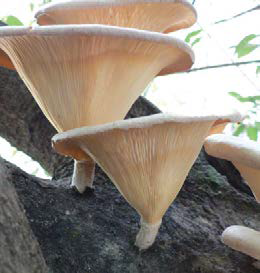
Over the last 20 years I have become fascinated with fungi. During that time I have lived at Maleny and been working on our property to help turn a run-down dairy farm back into a living, growing subtropical rainforest. This will provide habitat for wildlife, corridors of rainforest along Obi Creek and enhance the quality of the Sunshine Coast water supply. Over this period, we have produced lists of the plants growing on the property; the birds – both resident and visitors; and some of the mammals, frogs and invertebrates.
About 8 years ago, my interest in fungi changed from just appreciating their beauty to wanting to know their names, their function in the ecosystem and to make a list of the fungi on Dilkusha.
I mentioned this new interest to a mycologist (one who studies fungi) friend and he laughingly replied, “that would be the work of a lifetime!”. Always one to like a challenge, I decided to make a start!
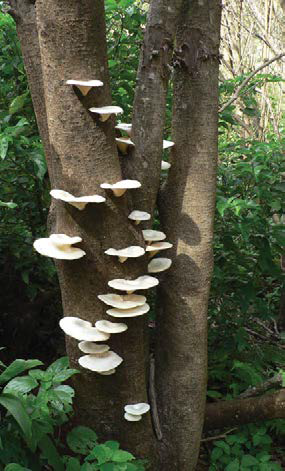
I very quickly realised that I had a lot to learn, and so I joined the Queensland Mycological Society where I could take part in forays, workshops, conferences and lectures to learn from knowledgeable ‘experts’ in the field.
It surprised me to find out that for a Kingdom as huge as Fungi (at least six times more fungi than plants in the world), there are very few expert mycologists in Australia and they are stretched thinly over the fields of taxonomy, molecular (DNA) analysis and environmental studies. So every time I discover a ‘new’ fungus on the property, there is a very good chance that it is the first time it has been described or collected in Queensland, or even in science. This is of course frustrating when I want to put a name to it, but it is exciting to know that ‘citizen science’ really can make a contribution to mycology. Observations made in one’s own backyard can provide new insights to old issues.
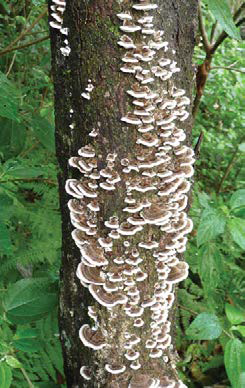
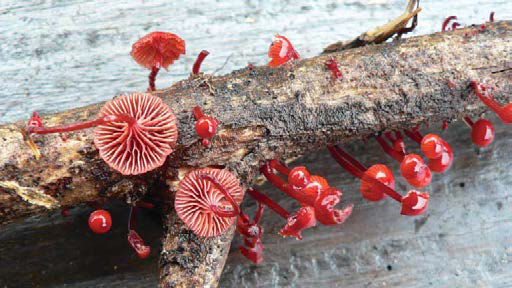
One of the first things I noticed at Dilkusha was that when we poisoned the Large- leaf Privet (Ligustrum lucidum), our major weed tree, the fungi very quickly moved in to break down the dead trees. The most common pioneer fungus on dead privet is Lentinus sajor-caju. It occurs in vast troops on the trunks, along fallen branches and on half buried roots. The fungus invades the trees almost as soon as they are killed. Fruiting of the fungus occurs in 6–12 months and then continues repeatedly over the next 3-4 years, until the tree is completely rotted and can fall down with almost no damage to surrounding vegetation.
After the initial onslaught with Lentinus sajor-caju, other fungi follow. These are often Turkey Tail (Trametes versicolor), which may cover the trunks with their brightly coloured fan shaped thin, leathery brackets. Both of these fungi produce enzymes that break down cellulose and lignin in the plant and produce a white brous residue. They are thus commonly termed ‘White Rotters’.
Another group of fungi that work on dead trees, both exotic and native, are the Auricularias, or ‘Cloud Ears’. Four different species of this Genus can be found in South East Queensland. They are often included with the group of fungi called ‘Jellies’, but may be quite tough and rubbery rather than jelly-like.
As well as these large amboyant fungi on the trees, there are many small fungi at work on the fallen leaves and twigs.
These include tiny Mycenas and Marasmius species, many of which have not been named.
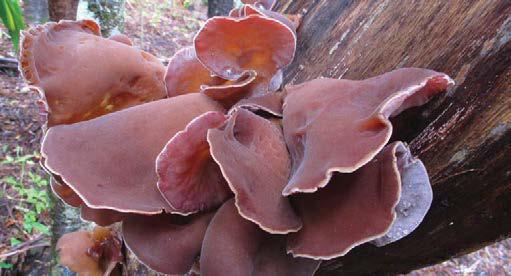
What most people refer to as fungi is usually the colourful fruiting bodies that we see above the ground. However, the majority of any fungus lies hidden in the wood, leaf litter or soil where the fruiting body is growing. The mycelia, or threads of fungus that are growing through their substrate, form a mat binding leaves and twigs together, which help prevent surface erosion and retain moisture while breaking down individual leaves and twigs.
Dead Lantana comes with its own suite of ‘rotters’. These look delicate and the fruit bodies last only a few days, e.g. Campanella species. Yet we have seen repeatedly that Lantana is completely broken down within about 18 months by these powerful little rotters. Eventually, all the dead material has been recycled into rich humus, perfect for growing a new rainforest. Without the whole group of decomposers recycling dead organic matter, we would be head high in debris!
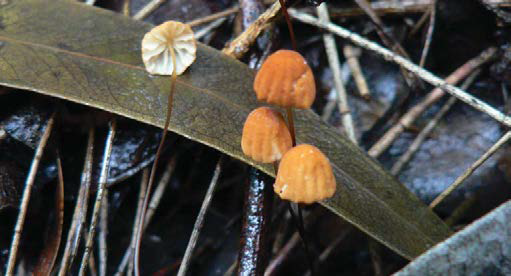
And that is only the beginning of the story of how fungi and plants interact in mutually beneficial ways.
All fungi shown here are described in Australian Subtropical Fungi – the first field guide to fungi covering the region from Coffs Harbour to Gladstone.
Article and photos by Frances Guard Land for Wildlife member “Dilkusha” Nature Refuge, Maleny, Sunshine Coast

Hi Frances,
I would like to know if this fungus is Lentinus Sajor-Caju. I took the photo on the Obi River near Maleny last May:
https://www.inaturalist.org/observations/21043868
Thank you,
Mel
Thank you very much for this article Frances. I had just found some small bright scarlet little mushrooms among the lantana and wondered what they were – they look just like your photo of Ruby bonnet. Is there anything else in this area that looks similar in your experience?
Steve Burgess, Wurraglen Nature Reserve.